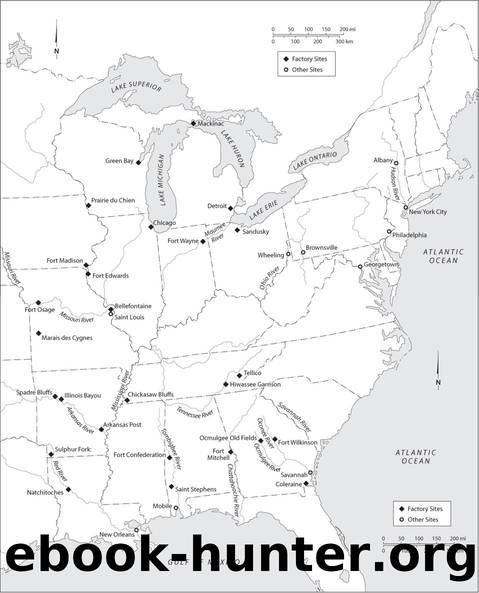Engines of Diplomacy by David Andrew Nichols

Author:David Andrew Nichols [Nichols, David Andrew]
Language: eng
Format: epub
ISBN: 9781469626918
Google: LBa9jwEACAAJ
Publisher: University of North Carolina Press
Published: 2016-01-15T00:43:22+00:00
Wild rice, an aquatic grain harvested by Lakes Indian women, served as an important foodstuff in the upper Mississippi Valley. John Johnson accepted it in trade at the Prairie du Chien factory. Seth Eastman, Gathering Wild Rice, from American Aboriginal Portfolio by Mary Eastman (1853), courtesy of the Rare Book Collection, Wilson Special Collections Library, University of North Carolina at Chapel Hill.
Johnsonâs frontier-exchange commodities included several hundred bushels of corn and several hundred pounds of âwild oats.â This last was actually wild rice, a high-protein food that Menominee and Ojibwa women harvested from aquatic grasses, using carved sticks to knock the plantsâ edible seeds from the stalks into their canoes. Indeed, many of the Prairie du Chien factoryâs purchases were the products of female labor: Indian women mined the lead, decorated the leather goods, wove the mats, and harvested the rice and corn that Johnson shipped or stocked. The factoryâs purchase of these wares did not necessarily empower Indian women, but its infusion of female-âgenderedâ produce, particularly plant foods, probably helped assure local Indians of Johnsonâs peaceable intentions, since he willingly received as well as extended hospitality.40
During its nextâand, as it turned out, lastâthree years, the trading houseâs business fell off, particularly its purchases of lead and muskrat fur. Johnsonâs average annual shipments of lead fell 40 percent between the 1816â19 period and 1820â22, and average annual muskrat exports declined 25 percent. The total invoiced value of all goods shipped from the Prairie du Chien factory between 1820 and 1822 totaled about $20,250, an annual average of $6,750âwell below the annual average of $11,300 for 1816â19. Johnsonâs purchases of raccoon did grow, and he also bought three tons of feathers (probably intended for mattress stuffing) and more Indian âcuriosities,â including a childâs cradle. Overall, though, shipments were 40 percent smaller (by invoiced value) than they had been in the trading houseâs early years.41
Business declined at Prairie du Chien trading house thanks to a problem it shared with other factories: private competition from traders whom Johnson could not incorporate into his network. Increasingly this competition came from the employees of New York fur magnate John Astor, who in 1817 had merged the old British and American Southwest Company with his American Fur Company and expanded into the Mississippi Valley. By 1819 John Johnson reported that âAstor and his opposition fairly fills the [Mississippi] River from Fort Edwards to the River Saint Peters.â In addition to their greater numbers, Johnsonâs private competitors enjoyed the advantage of extra-legally selling liquor to the northern Great Lakes Indians. The regionâs Indians considered alcohol a vital adjunct not merely of trade but of diplomacy; the Ojibwas, for instance, referred to liquor as âmilk,â the fundamental gift a parent gave to its child, and expected traders who claimed a fictive kin relationship with them to dispense it. Johnsonâs legal inability to do so undermined his status not only as a trader but as a parental official of a paternal government.42
Still, Johnson soldiered on, and with the help
Download
This site does not store any files on its server. We only index and link to content provided by other sites. Please contact the content providers to delete copyright contents if any and email us, we'll remove relevant links or contents immediately.
Harry Potter and the Goblet Of Fire by J.K. Rowling(3025)
Never by Ken Follett(2873)
Shadow of Night by Deborah Harkness(2710)
Ogilvy on Advertising by David Ogilvy(2678)
Zero to IPO: Over $1 Trillion of Actionable Advice from the World's Most Successful Entrepreneurs by Frederic Kerrest(2377)
The Man Who Died Twice by Richard Osman(2290)
Machine Learning at Scale with H2O by Gregory Keys | David Whiting(2269)
Book of Life by Deborah Harkness(2259)
How Proust Can Change Your Life by Alain De Botton(2256)
My Brilliant Friend by Elena Ferrante(2218)
0041152001443424520 .pdf by Unknown(2214)
The Tipping Point by Malcolm Gladwell(2202)
How to Pay Zero Taxes, 2018 by Jeff A. Schnepper(2095)
Will by Will Smith(2033)
Purple Hibiscus by Chimamanda Ngozi Adichie(1979)
Hooked: A Dark, Contemporary Romance (Never After Series) by Emily McIntire(1932)
Borders by unknow(1780)
Rationality by Steven Pinker(1761)
Daughter of Smoke and Bone by Laini Taylor(1738)
